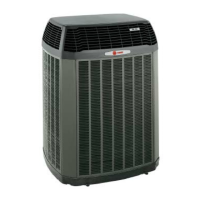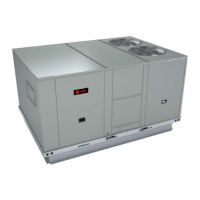28
RT-SVX057F-EN
☐ Make sure that all retaining screws are reinstalled in
the unit access panels once these checks are
complete.
☐ With the unit running, check and record the
following:
– ambient temperature
– compressor oil level (each circuit)
– compressor suction and discharge pressures
(each circuit)
– superheat and subcooling (each circuit)
Record this data on an “operator’s maintenance log”
like the one shown in Sample maintenance log table in
Final Process Section. If the operating pressures
indicate a refrigerant shortage, measure the system
superheat and system subcooling. For guidelines, refer
to “Compressor Start-Up,” p. 24.
IImmppoorrttaanntt:: Do not release refrigerant to the
atmosphere! If adding or removing
refrigerant is required, the service
technician must comply with all federal,
state and local laws. Refer to general
service bulletin MSCU-SB-1 (latest edition).
Heating Season
☐ Inspect the unit’s air filters. If necessary, clean or
replace them.
☐ Check supply fan motor bearings; repair or replace
the motor as necessary.
☐ Inspect both the main unit control panel and heat
section control box for loose electrical components
and terminal connections, as well as damaged wire
insulation. Make any necessary repairs.
☐ Verify that the electric heat system operates
properly.
Coil Cleaning
Regular coil maintenance, including annual cleaning
enhances the unit’s operating efficiency by minimizing
the following:
• Compressor head pressure and amperage draw
• Evaporator water carryover
• Fan brake horsepower
• Static pressure losses
• Airflow reduction
At least once each year, or more often if the unit is
located in a “dirty” environment, clean the condenser
coils using the instructions outlined below. Be sure to
follow these instructions as closely as possible to avoid
damaging the coils.
WWAARRNNIINNGG
HHaazzaarrddoouuss CChheemmiiccaallss!!
FFaaiilluurree ttoo ffoollllooww tthhiiss ssaaffeettyy pprreeccaauuttiioonn ccoouulldd
rreessuulltt iinn ddeeaatthh oorr sseerriioouuss iinnjjuurryy.. CCooiill cclleeaanniinngg
aaggeennttss ccaann bbee eeiitthheerr aacciiddiicc oorr hhiigghhllyy aallkkaalliinnee aanndd
ccaann bbuurrnn sseevveerreellyy iiff ccoonnttaacctt wwiitthh sskkiinn oorr eeyyeess
ooccccuurrss..
HHaannddllee cchheemmiiccaall ccaarreeffuullllyy aanndd aavvooiidd ccoonnttaacctt wwiitthh
sskkiinn.. AALLWWAAYYSS wweeaarr PPeerrssoonnaall PPrrootteeccttiivvee
EEqquuiippmmeenntt ((PPPPEE)) iinncclluuddiinngg ggoogggglleess oorr ffaaccee sshhiieelldd,,
cchheemmiiccaall rreessiissttaanntt gglloovveess,, bboooottss,, aapprroonn oorr ssuuiitt aass
rreeqquuiirreedd.. FFoorr ppeerrssoonnaall ssaaffeettyy rreeffeerr ttoo tthhee cclleeaanniinngg
aaggeenntt mmaannuuffaaccttuurreerr’’ss MMaatteerriiaallss SSaaffeettyy DDaattaa SShheeeett
aanndd ffoollllooww aallll rreeccoommmmeennddeedd ssaaffee hhaannddlliinngg
pprraaccttiicceess..
Microchannel (MCHE) Coils
NNOOTTIICCEE
CCooiill DDaammaaggee!!
FFaaiilluurree ttoo ffoollllooww iinnssttrruuccttiioonnss bbeellooww ccoouulldd rreessuulltt iinn
ccooiill ddaammaaggee..
DDOO NNOOTT uussee aannyy ddeetteerrggeennttss wwiitthh mmiiccrroocchhaannnneell
ccoonnddeennsseerr ccooiillss..
UUssee pprreessssuurriizzeedd wwaatteerr oorr aaiirr OONNLLYY,, wwiitthh pprreessssuurree
nnoo ggrreeaatteerr tthhaann 660000ppssii..
FFoorr aaddddiittiioonnaall iinnffoorrmmaattiioonn rreeggaarrddiinngg tthhee pprrooppeerr
mmiiccrroocchhaannnneell ccooiill cclleeaanniinngg pprroocceedduurree,, rreeffeerr ttoo RRTT--
SSVVBB8833**--EENN
Due to the soft material and thin walls of the MCHE
coils, the traditional field maintenance method
recommended for Round Tube Plate Fin (RTPF) coils
does not apply to microchannel coils. Moreover,
chemical cleaners are a risk factor to MCHE due to the
material of the coil. The manufacturer does not
recommend the use of chemical cleaners to clean
microchannel coils. Using chemical cleaners could lead
to warranty claims being further evaluated for validity
and failure analysis.
The recommended cleaning method for microchannel
condenser coils is pressurized water or air with a non-
pinpoint nozzle and an ECU of at least 180 with
pressure no greater than 600 psi. To minimize the risk
of coil damage, approach the cleaning of the coil with
the pressure washer aimed perpendicular to the face of
the coil during cleaning. Optimum clearance between
the sprayer nozzle and the microchannel coil is 1”–3”.
Final Process
For future reference, record the unit data below in the
blanks provided.
MMaaiinntteennaannccee

